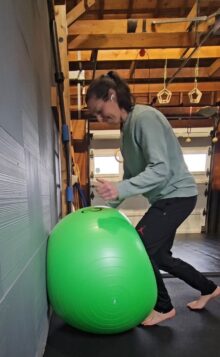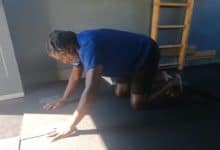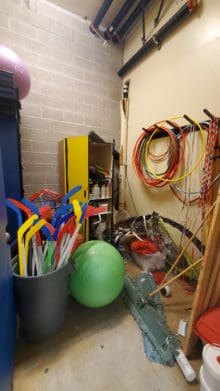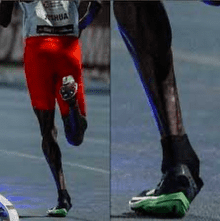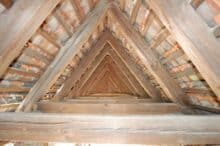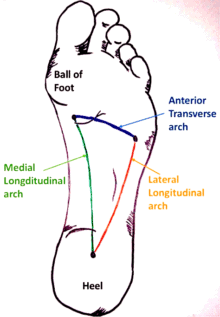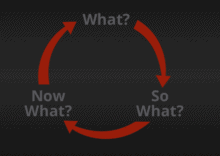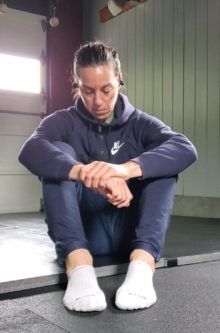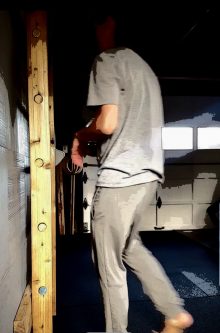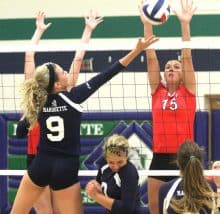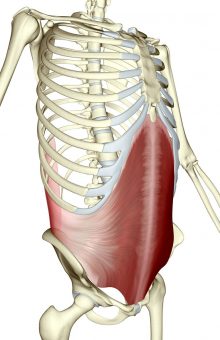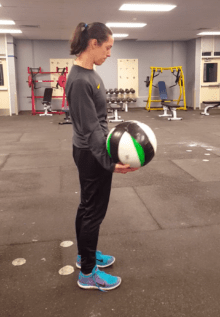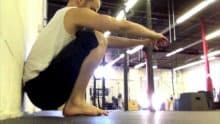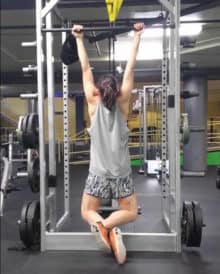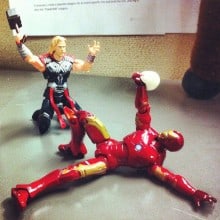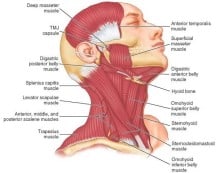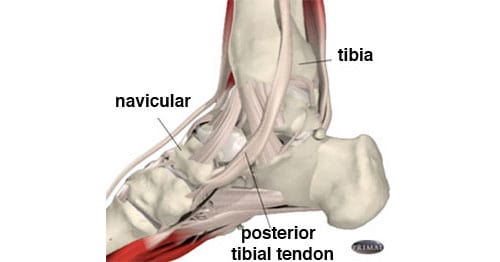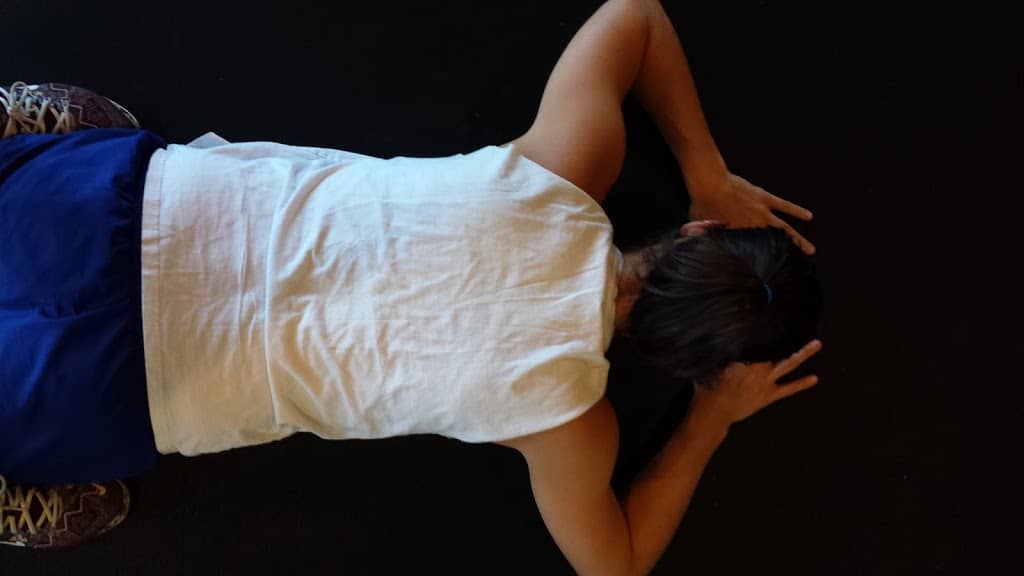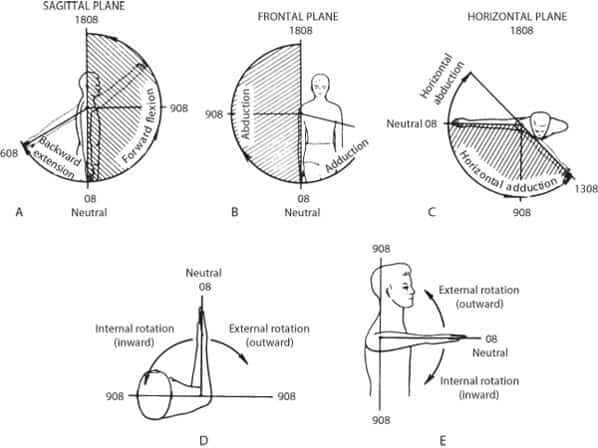In part one of this series, I teased out the why and how of getting students to be brought into the process of learning and course development. This follow up will share the ‘what’ — the tests we track, the… Read more ›
Being able to make decisions is a form of ownership, and having ownership leans on being accountable for your decisions. If we want people to be responsible for the health of the bodies they inhabit, to care based on… Read more ›
That which is neglected has the utmost potential. For me, Physical Education (or PE) is that place and space, and a fairly reflective representation of myself. Take the time and interest to look closer, past the beige tinge and the… Read more ›
The only mental to physical bridge I will use in this post is that when your movement and your life are aligned, when they reflect the same themes and sentiments, you cannot help but see application and connection to everywhere… Read more ›
To cultivate is to note what is, and then steer what you notice toward a particular aesthetic or ambition. In a place that is not my own, or with people that I do not feel responsible for, I can linger… Read more ›
Alternative Title: Describing the Avoidant Half I have been writing about asymmetries for some time. Whether it be determining the up leg from from down leg, or the pitfalls of detorsioning the system, I continue to find and… Read more ›
I’ve been teaching PE for twenty-three years. I’ve seen and survived a lot of things, just as my students have. The last five years have been particularly trying, both personally and professionally, culminating in a 2025 that rocked me to… Read more ›
I went to church today. It’s been a while. I was compelled to visit that Abbey that I took you to when you first visited me. We walked the ground and you confessed your sins. I keep a picture of… Read more ›
I always feel so sad when I watch the evolution of what youth ‘training’ has become. Led by adults who have forgotten/lost/never-had-the-chance-to play, we are applauding the work our kids do. We reward effort and discipline instead of creativity and… Read more ›
Asymmetry. Up Leg. Compression. Push Down. Space. Rotational Organization. These all describe the physics of one half of the body accepting load, and one half of the body avoiding load. The first time I wrote about this, I referred to… Read more ›
In my athlete days, which ended about 15 years ago, the goal was to NOT feel and just complete the tasks put to paper. It was something I was given or sought out — “more” was agreed upon by all… Read more ›
For those that might not know, Mr. Miyagi taught a teenage boy martial arts through a series of long-term tasks. He had him wax his cars, sand the floor, paint the house siding, and then paint the fence. Each one… Read more ›
The first post in this series asked if a pigeon toe was friend or foe. It is certainly a strategy, an adaptation that has a purpose. For me, my half with the pigeon toe also carried my biggest problems, particularly… Read more ›
Oh, the mighty pigeon toe. Such a strange little insurgent, and yet, it exists peacefully all around us. Where does it come from and how does it form? Does it afflict one leg or both? Is it the tibia or… Read more ›
The PE class I created was carefully called Games & Practice. The goal is to develop skills and then utilize those skills in a larger, faster context. Sometimes this means adding people, sometimes this means creating a more complex task,… Read more ›
Part One of this series looked at working with youth. My Dad is going to turn 78 this year. He is someone that I love and that I know loves me. Sometimes a close relationship can get in the… Read more ›
Whether you know what to do or don’t know what to do, these behaviors have been learned (and taught). The environment one finds themselves in caters to these patterns, and is socially accepted (and encouraged). Our habits define who we… Read more ›
I usually write these up at the school year’s end. But with nine weeks left in the semester, it seems pertinent to bring to light some things I have realized and have been chewing on for some time. (If you… Read more ›
At the very beginning of the pandemic, I posted and article that asked, “How does one know what to do?” In it, I used the example of Kevin McCallister (via Home Alone) mimicking ‘adulting’ after his initial indulgence into… Read more ›
Part 1 of this series explained how knee should not be used as a load-bearing joint. Part 2 showed how pressuring the knee can help build safety, alignment, and desired force at the desired time. This third and final segment… Read more ›
In part 1, I suggested that using the knee as gas instead of brakes could help free up the knee for motion and elicit the hips and ankle-foot as stabilizers. For folks with chronic pain, however, their nervous system likely… Read more ›
There are three hinges on the feature photo door. It’s a strong front door, solid and meant to take some battering. The cheaper, lighter, all-have-problems-closing-and-opening doors inside the house have only two hinges. Weight-load divided by two, or weight-load divided… Read more ›
Torsion. We all have it: a particular line of twist running through our carriage, gripping us in a certain way and keeping us upright. Each fold and joint tells its story, whether you realize it or not. It’s how we… Read more ›
At its core, this get together was a homage to Adarian Barr. It was about curious and capable mortals grasping at genius, and that genius laying out his latest findings and figurings in a simple yet thorough process of feeling and… Read more ›
Part One of this series looked at how taboos with genital region issues normalize them. Part Two investigated how anatomy shapes action. This third and final installment hopes to outline some systemic patterns that might feed into pelvic floor dysfunction.… Read more ›
Three simple steps towards a state of satisfaction: 1. Get hurt. Physically, this is a no brainer. That skill or peak performance will not seem as important as getting out of pain. Mental-emotionally, this might be even more obvious.… Read more ›
My previous post got into the shame and embarrassment that prevents many of us from addressing issues with parts connected to sex or excrement. This one is more objective, looking at anatomy and physics. When you seek to understand the… Read more ›
This feature photo shows an unstaged photo of the top drawer of my filing cabinet in my locker room office. Note the bounty of certain items (that aren’t snacks). Shorts, pads, some extra underwear — all tell tale signs… Read more ›
I define performance for the purpose of this article as, “the peak execution of a skill at a particular point in time.” Though sometimes cooperative, there is most often an element of competition involved. For most athletes and artists, the… Read more ›
There is an assumption that young people are able-bodied. It is the gift of youth, the privilege of being newer to this world designed to break you down. It has become incredibly apparent, though, particularly in this last semester, that… Read more ›
Habits and attitudes. At its core, this is what teaching comes down to. Do you know how to break them? Do you know how to build them? How do you feel about the things you do every day? Are they… Read more ›
Part One looks at identifying each leg and how each prioritizes a different foot arch. Directional Bias: Perpendicular vs. Parallel. Up leg works the foward and back (parallel to ground). Down leg works the up and down (perpendicular… Read more ›
To recap Part One: Create a sense of intrigue Provide multiple points of entry Establish pockets of safety Ask instead of assume This sh*t’s hard (which is why so few do it) After the weight shift lesson , three of… Read more ›
When planning a lesson that is skills based, you must account for multiple points of entry. In public education, everybody and every body must be able to find some success. You also must be able to do what you are… Read more ›
I am the only female in my high school PE department. It’s been this way for 20 years. The one time another female came in she tried to out-alpha the football coach and got removed from teaching PE and placed… Read more ›
While walking through the streets of Europe last Spring, Adarian Barr wondered why his feet felt so good. He traced it back to the cobblestones. The lift, the variability, the multiple points of potential folding. This was the impetus behind… Read more ›
When new words are introduced, we tend to react as if they make things more complicated. We already know. We already have an understanding on what the terms we already use mean. Why would we change? We change when we are… Read more ›
Pairs. Roles. Asymmetry. The body knows and the body has ways. Understanding the differences between the halves helps you appreciate them. One side isn’t ‘good’. The other isn’t ‘bad’. They hold a function within the system. Here’s a big picture… Read more ›
To belong implies a selection was made. There was a choice and options. In my rugby years, making the Select Side was a sign of being elite. You were one of the best in your region. You were chosen from… Read more ›
Flexion and extension. Compression and Suspension. There are pairs that govern movement, both globally and locally. The system and its parts act to pull apart and come together. Posture, moving fast, and any sort of training or exercise is versed… Read more ›
Amongst other things, COVID-19 revealed how fragile the American educational system is, and how unadaptable it is to changing and evolving times. Designed to churn out compliant workers, it conflicts with the world around them — a burgeoning economy of… Read more ›
This piece serves as the follow up to How To Push Down. When we are talking about compression, we are also talking about tension. It is the interaction of these two push-pulls that creates suspension. Otherwise everything would collapse. … Read more ›
Part Four in a four-part series of relational examinations. Part One: Parents Part Two: Pets Part Three: Students The definition of peer that I most relate to is “looking at”. The people who were supposed to be ‘like… Read more ›
Part Three in a four-part series of relational examinations. Part One: Parents Part Two: Pets I never had any aspirations to be a teacher. I’d planned on becoming a physical therapist, but when it became clear that the training… Read more ›
Part Two in a four-part series of relational examinations. Part One: Parents I can think of no purer love than that of a dog for its person. They just want to be with, and play, and interact, and protect,… Read more ›
Part One in a four-part series of relational examinations. The family is your first introduction into relationships. They are the constant you are surrounded with, the base in which all other units are compared. The two people that set… Read more ›
It has become wildly apparent that neglect leads to destruction. The planet, the houseless, bodies, trauma, young people. ( I could add the elderly or just ‘people’ there as well, but older people tend to have and want to keep,… Read more ›
Each of us resides in our own world. It may be one we created, one we filtered out from experience, or one that revolves around our investments in habit and attention. Once established and found comfortable, it becomes a prism… Read more ›
Physical Education classes have gotten bigger over the course of the pandemic. The powers that be have knowingly placed too many kids within too small an area. Like athletics, it seems to have a separate set of rules that allow… Read more ›
My left leg has some problems. I could fill in the whys with any number of stories — the many ankle sprains during my athletic career, the torn and hamstring-repaired ACL, the pigeon toe I gave myself because of a… Read more ›
Adarian Barr does this thing. Well, first he does his thing — take a snapshot of what is going on in a way that only he seems to notice. Then he’ll send it to me without words and see what I… Read more ›
This is a question that requires more probing questions. Must there be a unifying variable of sameness? If so, what is it? The age of the people? The thematic subject? What actions are expected? How about the time of day? … Read more ›
This post serves as a follow up to: A Path Towards Harm. Otherwise titled: The things I did wrong when I didn’t pay attention or have compassionate patience. The tag to this blog used to read, “fix yourself.” But… Read more ›
Some context. I have been learning to be sensitive to signals of and mitigate pain for about a decade now. My training revolves around feeling things out, noticing any off-ness, spending some time and attention there, and finishing the session… Read more ›
Push down. Seems simple enough. Intuitive. But I got it wrong. I got it wrong because my posture and mechanics favored a front-side dominance. (Quad-dominant folks tend to also fall into this category.) The knee bend, rounded shoulders, and dropped… Read more ›
Feature photo caption: “A picture of my brother in PE class today.” I wonder how many people within the work can admit it isn’t working. Kids can say it. Parents can say it. Academics who perhaps used to teach… Read more ›
This post serves as a companion piece to A Non-Central Axis. Where it showed you ways to identify a shifted midline, the following hopes to show how pulling to the right or left affects performance. The first thing to… Read more ›
This piece serves as a follow up to “The Problem with Meaningful Phys Ed“. Amidst a pandemic, the question that kept driving what we did and how we did it was, “What matters?” Weirdly, and almost embarrassingly, this did… Read more ›
As I start to look outward in my professional career, I keep running into this study about Meaningful Experiences in Physical Education and Youth Sport. In it, “five themes were identified as central influences to young people’s meaningful experiences in… Read more ›
Photo by Linus Nylund on Unsplash I am very quick to sort information. I try not to bias it from the source. What is interesting becomes useful when you know what to look for and how to apply it… Read more ›
Everything I know about the transverse arch, I owe to Adarian Barr. The following is my attempt to take his words and concepts and relate them to my own body and understanding. It is, in effect, my translation. The layers… Read more ›
About 9p, while I was more than halfway to sleep, the power went out. I didn’t think much of it. It goes out every now and then, and it always comes back on within reason. When I woke, I peeked… Read more ›
Part One. Part Two. At a friend’s 40th birthday party, a question was asked of the four ladies in attendance. “If you had 72 hours left to live, how would you spend it?” I immediately knew my answer, but… Read more ›
[Part One can be found here.] “The Ghost’s of Chris’s Present” Individuals are my jam. They are complex in a singular way. It is easy to give them my undivided attention. It is easy to gather data points. Instead… Read more ›
Alternative title, “The Ghost of Chris’s Past” [Part One of a three part series to help me better understand and create community.] Being social has always been a function of sports. Teammates congregated for practice and games. I wanted… Read more ›
The two bowls of the torso work in relation to one another. The ribs act as an upside down bucket and psoas sticks. The pelvis acts as as a rotary basin with hip handles. Should they be able to freely… Read more ›
The last several weeks of Quarter One had assignments based on defining care, creating change, and challenging accepted truths. If our beliefs shape behavior, then either place can act as a starting point to disturb or disrupt the other. Conversations… Read more ›
From October 17th, 2020, a month into the school year and six months into the COVID pandemic. SLIDESHOW PDF
This is the third in a series of real-time, as it happens articles about leading online Physical Education. [Part one can be found here. Part Two can be found here.] We ended the last segment with a knowing need… Read more ›
Some quick context about the current teaching/ learning parameters of Distance Learning for the district I work for. 1. Block classes meet four times per week. There are four total classes per day, and teachers teach three of these sections… Read more ›
Typically, when I write, I try to give an overview of a completed loop of learning: this is where I started, this is where I went, and this is what I found. As a public educator in the midst the… Read more ›
I received an email from Daniela Welzel, whom I do not know. It was obviously of the bulk variety, not even a name in the greeting, and it touted its magnitude and asked if I was interested. I didn’t know… Read more ›
A year ago, I published ‘Dead Ribs‘, documenting the neglect of my ribcage in favor of my pelvis. Other than examining lateral movement, the breakthrough there was that to open the ribs I could lengthen through the front rather than… Read more ›
From the perspective of someone looking for you, you will be found more readily if you are specialized. A handy man might be able to fix your furnace, but a furnace guy definitely could (should?). And yet, if I needed… Read more ›
Paying attention brings awareness that paves the way for learning. While the task of directing attention typically goes to teachers, the chore of controlling attention falls on the student. We are bored by things that don’t seem to apply to… Read more ›
I write this still teetering on the edge of letting go of a belief that I thought defined me. I never wanted to be anyone but myself, and lived in accordance with that desire. And yet, if I try to… Read more ›
A quick conceptual piece from the mind of Nicole Uno. Like many sensational metaphors she offers me, I cannot quite make sense of things until I feel it’s application and usefulness. Instead of trying to force the issue, I typically… Read more ›
How do people know what to do when their structure of doing is removed? If they had choice and input to create the structure they lived within, and it served them well — fostering security and growth — they would… Read more ›
This hurts. The most common reaction is to stop using it or doing that. It’s even the advice of many medical professionals. Rest, it is assumed, is a cure all. But what happens when this magic pill doesn’t work? When… Read more ›
If something is stable, it can accept more than itself. Adding load then, signifies a sureness of support — a confidence in the structure of self. Though often treated as static, the load, structure, and interactive adaption to stress is… Read more ›
The following video drummed up tons of interest in Bal-A-Vis-X over the past year: It’s how I was made aware of it. I was tagged via facebook, twice. While certainly intriguing and catchy, these edits of action do not… Read more ›
Kids on a playground at recess choose their environment. They enjoy it because there are no expectations — nothing has to be done nor are they confined to a singular place. They can be around people or take space for… Read more ›
Three years in the making, I became clear on the name for my class and what I hoped it could offer students. Up until this time, I got the same kind of kid – ones who prioritized learning and understanding… Read more ›
For the better part of a year, Nicole Uno has been offering me her insights on movement. There have been a few big picture concepts that have completely shifted my perspective (I’ll re-link these at the end), but perhaps the… Read more ›
For a very long time, I blunted my sensitivity. It left me open to being hurt. I had to learn not to be responsive to being receptive. I adjusted my interactions with the world to protect me from it. My… Read more ›
With every joint that flexes (and extends), there is an element of rotation attached. Three hundred and sixty moveable joints times multiple degrees of orientation at each makes for an almost unfathomable number of alignment options. Much moreso than correct… Read more ›
For many reasons and convergences of fate, I recently took on the assignment of coaching high school volleyball. It was a sport I knew very little about and had the least experience coaching and playing. It was also a position… Read more ›
The phrase ‘body mapping’ has many interpretations. It appears as nebulous as it is exact, with the user either struggling to communicate their construct or utilizing words so specific that it pigeon-holes the potential meaning into a singular stranded notion… Read more ›
Pullups. The bane of every chubby kid’s existence. We were strong, just not relatively strong. We liked to stick what we were good at, which was moving things other than ourselves. Eventually my weight leveled out and I was drawn… Read more ›
I really enjoy completing tasks. There is nothing too small or menial for the to-do list. Caring for my immediate environment involves constant problem seeking to avoid the need for large-scale problem solving. If I know what and where the… Read more ›
This is another concept coming from the astute observations of Nicole Uno. The medical, fitness, and wellness worlds are fixated on correcting imbalances. Amidst all the readily available treatment plans, too few remain curious about why so many asymmetries… Read more ›
People with a lot of stuff tend to be extraordinarily organized. They have to be in order to find things. What an onlooker might view as chaos and confusion is lived in as a place of comfort and convenience. The… Read more ›
It’s wretched. Absolutely awful. Carrying a heavy pack for miles and miles and never being quite sure when the end will come. I never notice my environment. I am fixated on the trail, the next step, and the necessity to… Read more ›
How does your ability to care for something affect how much you can enjoy it? When the yard is full of weeds you can’t pull and awry branches you can no longer trim, do you begin to despise the home… Read more ›
‘Critical Look’ challenges the way systemic information is presented and questions the story being told. SYSTEMIC IDEOLOGY: Create a New Normal in Physical Education. Personal background with system – Fifteen years of trial and error at a public high… Read more ›
Thematic teaching offers an umbrella students can return to to make their own connections. It provides a constant amidst the chaos to formulate conclusions and test variables against. Stepping back and trying to see the bigger picture of my classes,… Read more ›
Slings. I’ve heard them referred to often, but never quite knew what they were or why they were important. I understood that they were anatomically determined lines within the body, but in a structure that is fully connected, it didn’t… Read more ›
As I am learning to access and mobilize my ribs, I have begun to understand and control the deep inner workings of my trunk, particularly the space between the ribs and pelvis. One might think of this as the shortest… Read more ›
Part one of this series looked at the more physical elements of the “Weightlessness” workshop, and revealed the wonderful surprise of walking away with better knees. Part two will attempt to unveil the method behind the artistry of making a… Read more ›
Cecily Milne is the mind behind yoga detour, movement education that encourages the yoga population to go beyond ‘nailing poses’. She immediately reminded me of Marlo Fisken – a “pole person” who’s actual draw is that she is a brilliant… Read more ›
My pelvis has been my focus for the better part of a decade. Plagued by low back pain and steely hamstrings, I discovered that I was stuck in anterior tilt. Learning to posterior tilt both felt and functioned like… Read more ›
The nature of hurt is a protective hardening. It heeds and is hypersensitive to perceived warnings of “don’t”, so much so that it often re-wires them as “can’t”. Doubt barricades them into safe worlds where they are capable and can… Read more ›
This is the second post taken from the mind of Nicole Uno. It is a continuation of the first, explaining Rotational Organization. For the most part, we are floating. Skating and tip-toeing off the ground because we can. We have… Read more ›
Knowing grounds us. It keeps us on firm footing, aligning our steps in certainty. We are familiar with the route and look at our phones along the way. This compass does not compel us. It is routine and habitual. Believing… Read more ›
My relationship with my knee goes in waves of excellence and issue. In periods of calm when things are swell, I enjoy and explore freedoms and push the boundaries of performance. Preferring to walk the unrestricted line of what is… Read more ›
Interest dictates pretty much everything. It is the neck that turns the head and keeps curious eyes fixed. At its most illuminating and significant, it attracts the onlooker into their own inner workings. Believe that you are both interesting and… Read more ›
All assessments seek to answer questions. From the doctor’s intake form to “Which Gilmore Girl Are You?”, we are urged to think and speculate. When evaluating ourselves, we can become skewed by comparison or desired result. Only when we start… Read more ›
The following is part two of my course notes and findings from Stress, Movement, and Pain. As practitioners seeking to help bio-psycho-social organisms, we have to be able to read, analyze, and gather information from all three dimensions. The… Read more ›
The following is part one of my course notes and findings from Stress, Movement, and Pain. Linked through the perception of threat and cause to protect, Seth Oberst generously delivered on the hows, whats, and whys between sensation (or lack… Read more ›
The following is a glimpse into the mind of Nicole Uno (IG @unotraining). Rotational Organization allows for the simultaneous existence between contract and relax. Thoroughly simplified, consider two gears. There is an impetus of force and a corresponding area… Read more ›
A PE teacher on one side of the country texts her trainer pal on the other. “I was thinking of getting this textbook for my weightlifting class.” “Why do you need a textbook?” “So I have something to reference… Read more ›
A system is a method of getting particular results. It needs individual interpretation and application, however, to keep it alive and viable. Without an infusion of self, both the system and the user remain static. Integrated, everything evolves. Value lies… Read more ›
For a long time, I believed that extension was the working opposite of flexion. They felt as contrary as they looked. Folding forward was natural and effortless. Folding back was a resistance to that ease. The struggle was a lesson… Read more ›
If I learned one thing growing up in the Chicago suburbs, it’s that lazy people are really, really frowned upon. Being worth something meant you did something. You contributed; to the house, the team, the school, the community. Willingly making… Read more ›
When assessing the lower leg, it has become common place to examine the foot. The pliable and separable toes receive much of the attention. The heel, strange and seemingly uninteresting, gets neglected. Considering the calcaneous is a starting point… Read more ›
Two years ago, I set to develop a “new” type of PE that looked outside the realms of sport and weight lifting. With the outliers as my muse, we set to examine movement with a larger lens — how one… Read more ›
Matan Levkowich is a dancer, choreographer, and martial artist. Another of the incredible Israeli movers, he is able to pluck out threads from all the worlds he has immersed himself in and deliver them in practical form. He first blipped… Read more ›
Being interested lets a concept captivate you. It makes learning effortless. The desire to know is sought out. It involves the curious in an unconditioned quest for more. Something. Anything other than what currently is. Doing becomes a compelling deed,… Read more ›
If you’re curious about why only half a workshop I’ll tell that story at the end. Tom Weksler’s Movement Archery workshop was a lesson in angular momentum. We rolled, we spun, we bruised our pointy bits. Imagine an archer… Read more ›
The ego has many layers and interpretations. It can signify a sense of self, the definition of “I”, and/or the determination of esteem or importance. A psychoanalytical description fans this into, “the part of the mind that mediates between the conscious… Read more ›
Movement expression is dependent on on our tadpole-like head and spine to drive and disperse motion. Any sticking points have a reverberatory effect on the actions of the limbs. After a decade of undoing the rigidity trained through athletics and… Read more ›
When I got my first chin up, I felt superhuman. Finally hitting that relative strength benchmark felt like a magic trick I was somehow involved in. Even more mystifying, though, is that I had absolutely nothing on a pronated grip… Read more ›
Information is a tease that lures you to attach yourself with a particular paradigm. The consequence of consuming the free tastes is that you are left deficient. Once sampled, you’re not entirely sure what you just had, but you do… Read more ›
The low gait might be the truest test of healthy knees. It requires full flexion under full bodyweight while pulling the center of mass. A single knee is responsible for stabilizing load while the feet and ankles pivot and reposition.… Read more ›
Three months into the new school year, everything seems easier. As encouraging as my findings from the first year were, I wanted to further minimize my influence over their minds. To instigate thinking, one must ask provocative questions that the… Read more ›
Balance is a movement intelligence. It relies on systemic interdependence — that your parts work well enough and that the body can efficiently execute interpretations from the brain. Creating feet that grip and then utilizing them in skill-based, eyes closed situations bridges… Read more ›
There is a huge benefit to feeling like an outsider. You learn to trust yourself. Your different feels correct. You become excellent at observing and sifting, and finding your own truth. For a long time I mistook my almost constant… Read more ›
Plagued by forward head posture and phone-down eyes, the act of tilting the head back can become unnerving. Used to being underutilized, the cervical spine has to be coaxed into believing extension can be a position of comfort. The shoulders,… Read more ›
As I attempt to simplify and surface patterns, two questions, in various guises, keep cycling through my mind: Do you know how you’re doing what you’re doing? Could it be done another way? The first represents a semblance of awareness.… Read more ›
I enjoy writing this blog. It helps me make sense of things. I can connect the dots and string the pieces together, ultimately braiding them into a larger understanding. I try to communicate as if I was asked what I… Read more ›
Joint ‘popping’ is a curious thing. It alarms without hurting. Especially when you realize it wasn’t there before. You notice something is different when you do that particular thing in that particular way. The different becomes ‘less than’ when… Read more ›
Being a public educator means you will never be without students. The caveat is that many won’t want to be there. Shaped by a past experience of dodgeballs to the face and timed miles and pacer tests, Physical Education was… Read more ›
Engaging with your work demands a certain degree of ownership. There must be a benefit to the challenge presented, beyond just a hard-to-apply confidence. A task can serve as a test of will, a test of adaptability, and/or a test… Read more ›
Doing without knowing. Playing, creating, learning. Adjusting and adapting. Describing Fighting Monkey is an act in organizing verbs. Everything overlaps and intertwines and is a wonder. The only certainty you are left with is that you have experienced something good… Read more ›
In a top floor studio space that felt more like a cozy attic, I had a revelation. A soft-spoken yet commanding gal led me into my own body with an almost story-time cadence and tone. Knowing I was new, she… Read more ›
Issues with joints or body parts can almost always be traced back to usage. When faced with a familiar task in a familiar environment, our habitual patterns of movement follow a particular chain of command. We clutch and are clutched… Read more ›
It is on rare occasion that I am floored by what I hear on a podcast. While listening to fusion health radio on a recent commute, my eyes sprung open when I recognized what was being given away. The topic was Neuro-Somatic… Read more ›
“I’m going to explore the depths of the ocean.” “You’re gonna what?” “I’m going to get into this magical pressure suit, close myself off to the known world, and look for cool stuff.” “Why would you want to do… Read more ›
I live a charmed existence. I get to play with kids and problem solve painful movement with adults. Familiar with the importance of each, I also teach teens about pain and guide adults toward rediscovering play. I step between the… Read more ›
Movement overlaps. Brain work = joint work = speed, power, strength, and coordination work. We have structures and we have capacities. Our practice establishes the abilities of both. There is a general consensus that if your parts work better you’ll… Read more ›
Before we are funneled into a certain way of being, we believe we can do anything. We want to try everything because we have no idea what we can’t do. We are confident without realizing or understanding what confident is.… Read more ›
Body control is all the rage. A popular want is increasing active range of motion. People want to get there so they can do stuff there. Functional Range Conditioning uses slow, controlled movement to examine individual joints, build capacity in… Read more ›
You are willing to explore when you feel safe and confident. Safety comes from recognizing your limits and being able to measure and manipulate risk. Confidence comes from knowing what you’re doing and trusting in your ability to adapt. Experience… Read more ›
Hip extension is a vital movement to both health and performance. Wellness wise, hips that can extend, coupled with an unstuck spine and pelvis that can naturally posteriorly tilt, means you likely don’t suffer from back pain. Power and speed… Read more ›
I’ve been teaching PE for thirteen years. When I entered, I did what those around me were doing. I had been an athlete. I had great fun and success through sport, and I wanted to share this experience with the… Read more ›
This post serves as a companion piece to Pain Exploration: Medial Knee. It picks up right where it left off, with manipulations of the ankle, foot, and toes. A low sit with the heel up and toes extended (an expression… Read more ›
The magic of the internet is that it can connect strangers through a virtual world. Search boxes help find commonality and mutual interests. What is even more encouraging is that people are interacting. There is far less fear in speaking… Read more ›
Increasing dorsiflexion is a popular yet frustrating goal. Getting the ankles to do more lessens the strain on the knees, and is an important factor in being able to drop into a deep squat — an often used marker of overall… Read more ›
“The more complicated the environment, the more it takes you away from yourself.” I have a confession to make. I live in the land of Dewey Nielsen, and I don’t revel in being outside. I don’t mind it, and… Read more ›
The vast majority of movements happen going forward. We reach, walk, look, and move toward what’s in front of us. Then we sit by pushing our butt backward. This front-to-back plane of motion (or stillness) is where we reside. Our… Read more ›
As practioners and coaches, teachers and students, we are constantly seeking out information to make us better at what we are trying to do. We stalk and search. If only we could see and know, then we could do. Despite… Read more ›
Pelvic motion and knee flexion influence hip rotation. Structures above and below a joint have a direct impact on the way it functions. For the hip, its surrounding articulations are the knee and the pelvis. Stiffness or motion in… Read more ›
feature image photo credit: Alexander Yakoviev via freeyork.org “Re-creation develops the artistry of ‘finding the how’. Re-creation allows helpful acts to be reproduced. It infuses YOU into the creative process: solving problems, creating alternatives, and granting whatever time… Read more ›
For about two months, I’ve had some chronic discomfort in my left knee. On a scale of 1-10, with ’10’ being agony and ‘1’ being noticeable/annoying, it oscillates between 1 and 4. Though this might be thought of as acceptable… Read more ›
“Translation allows for otherwise separate entities to synapse and communicate.” I have been a teacher for thirteen years and a movement therapist for five. As I toggle through the two professions, an unlikely blend has taken place. I find… Read more ›
“To enjoy the process you have to re-frame desired results.” Give a kid a list of tasks to do, and you’ll find yourself with one unhappy kid. Give an adult a checklist, and they transform into blissful busyness. One… Read more ›
The pelvis speaks volumes. The position in which you hold it dictates whether or not you can use your abs, release your hip flexors, and/or likely have symptoms of back pain. It’s the first thing I check with new clients… Read more ›
We tend to move in ingrained patterns, within the same degrees and utilizing the same amount of space. Thinking bigger about what a joint is capable of doing allows us to use it in ways we don’t, which often aligns… Read more ›
Finding and being able to engage in what you’re passionate about is touted as the end all and be all of existence. Though loving what you do can lead to a love of self, it doesn’t quite translate into feeling… Read more ›
Sliding is one of the most fun ways to get from here to there. True to form, it’s also a sneaky little way to grasp an underlying understanding of movement. F=ma (force equals mass times acceleration) is explained in… Read more ›
feature photo credit: telegraph.co.uk Work has always made me feel accomplished. I did stuff simply for the sake of getting it done. Checking off a box or crossing off a project was immensely satisfying. Afterwards, I waited anxiously, bouncing my… Read more ›
Limitations in the wrist are the Achilles heel of push dominant training programs. Repeated gripping and hoisting of bars and bells turn the hands and wrists into one trick-ponies that get cranky when trying to press the body off the… Read more ›
Movement is communication. It is the giving and receiving of signals, of input and outputs. When you watch someone move, whether it be dancing or jogging or getting out of a chair, the manner in which they carry themselves and… Read more ›
Ah, gravity. The beautiful constant. 9.8 meters per second (squared) you can rely on again and again to hold you down. Many times we see it as our enemy, a hindrance to our speed and power. But in the world… Read more ›
featured photo credit: theindianschool.in I’ve had the good fortune to work at an arts school the last eight years. The students, many disenfranchised with Physical Education in the past, were open and willing to trying different things. I’m not… Read more ›
The tip toes position is an assessment of toes, feet, and ankle control. Balance comes from joint stacking. The push off when we walk comes from a high heel. A toe point or push is required with reaching. Loaded plantar… Read more ›
As a young athlete, I did whatever my coach told me without asking questions. I rewound video tape of Michael Jordan again and again to get the footwork right. As I aged, I accepted and attempted to perform summer programs… Read more ›
Thirteen years ago, I had ACL reconstruction surgery using a hamstring graft. My tissues have long since ‘healed’, but the overall function still lacks behind my non-injured leg. Full flexion remains it’s biggest weakness. Here’s snapshot of the discrepancy in… Read more ›
My father takes pride in being a worker. He grew up poor in Italy and emigrated to the U.S. when he was 16. He had $20 in his pocket and no grasp of the English language. Somehow, though, like so… Read more ›
feature photo credit: Dr. Andreo Spina Tibial rotation is necessary for keeping the knees in line with the ankles during a deep squat. It also greatly influences walking gait and joints of the knee, hip, ankle, and foot. Issue… Read more ›
There are two ways to leave something — choosing or being forced. The decision to walk away from something is based on faith and competence. There are few things more empowering than making plans to leave and following through with… Read more ›
featured photo credit: morphopedics.wikidot.com Stiff hips cause pain, injury, and lackluster performance. A freely rotating hip is likely to flex, extend, abduct, and adduct with ease. Restrictions with any of these movements can often be traced back to restrictions in… Read more ›
The mobile nature of the shoulders leaves them vulnerable to influence. The way we consistently hold them is the way they’ll stay. Slouched postures slumped over desks or protecting their personal interest in cell phones and video game controllers adapt… Read more ›
For any of you who have followed this blog for a while, the pelvis has been a long-standing fixation of mine. It has routinely been the deciding factor in moving better and getting out of pain (particularly low back pain). Boldy put, if… Read more ›
This is an ode to mothers everywhere. Your ability to give and withstand suffering makes you the most exceptional people on earth. The following is one daughter’s account of how her mother shaped her, and how knowing her story put… Read more ›
featured photo credit: @movnat instagram (Carlos Condit) The ground is a safe, secure place. It is not something to be avoided or stepped lightly onto. It can easily absorb our falls and placements and pressures. If we become afraid… Read more ›
feature photo credit, Moshe Feldenkrais and Magic Johnson: feldenkraismethod.com People want to be self-sufficient. There is an immense satisfaction in being able to pinpoint what is wrong and develop a strategy in how to fix it. The process of correction… Read more ›
For a very long time, my ability to do work was my defining feature. I needed to get stuff done to prove myself capable and worthwhile. When I was younger my Mom made us chores lists. She wrote them on… Read more ›
The one flaw in the Functional Range Conditioning system is its heavy use of acronyms. It has created a culture of separation, utilizing a language only understood within the context of the FRC group. Starting with CARs and developing into the… Read more ›
Dear high school athletes, Sport can teach you a lot of things. It can help you understand self-belief and show you how to contribute to a group. It can make you feel as if you belong. It can provide you… Read more ›
As someone who’s pretty much focused solely on joint/movement work for a while, my conditioning is far from what it used to be. I entered a no-dribbling 2-on-2 drill with some kids during class and my heart almost exploded. It… Read more ›
The dirt must have confidence. It’s capable of so many things! Even if no one notices and it doesn’t look like it’s working, it gets some pretty amazing stuff done. It holds up the entire world, grows plants, supplies food,… Read more ›
As examined in my previous post, joint function defines what kind of movements you are prepared to perform. Articular independence must come before articular interdependence. The ability to isolate a particular joint leads to more control, increased awareness, and lessening… Read more ›
The popular — and still conceptually relevant — joint-by-joint approach championed a decade ago lent logic to the idea that a problem that revealed itself in one area may be caused by dysfunction in another. There were stable joints, and there were… Read more ›
Not long ago, I was that person who spent *hours* creating the perfect workout playlist. I knew exactly which movements I would perform and how long my gym session would be. I’d time the up songs with the hardest part… Read more ›
Controlled Articular Rotations (CARs) are the entrance point to Dr. Andreo Spina’s Functional Range Conditioning system: They are meant to: 1. assess joint health (particularly the function of the deep joint capsule) 2. maintain outer… Read more ›
I suffered a partial tear of my left ACL in 2003 during a rugby match. There isn’t a cool or gruesome backstory involved, just some open-field running with the ball. One cut and down I went. And stayed down. It… Read more ›
featured photo credit: jimmy nelson, beforethey.com Humans are hard-wired for connection. Brene Brown’s fantastic work continues to dig into this truth. The purpose of connection is not to simply fit in; it’s to belong. The difference is immense. Fitting in is… Read more ›
Functional Range Conditioning (FRC) is a system of creating, controlling, and expanding useable range of motion, defined as mobility. Unlike flexibility which is typically achieved passively, FRC uses tension and isometrics to minimize neurological safeguards that inhibit mobility in the… Read more ›
Here’s my presentation from last weekend’s FREE Salem Fitness Summit. I’ve learned my lesson to keep the lights on ( a habit from the classroom). The brighter slides help a person emerge from the shadows. The audio, thank goodness, is… Read more ›
Yesterday, Guido Van Ryssegem was gracious enough to speak to us at the Free Salem Fitness Summit. While his topic was “Resolving Upper Extremity Movement Dysfunctions”, he delivered plenty of nuggets regarding motor learning in general. Here are three gems I… Read more ›
Losing weight won’t make you a hero. It’ll trap you in a way. To keep it off or keep up the facade that because you’re thin everything’s great. If you’re assuming that reaching that body weight goal is going to… Read more ›
If you’re stuck in a movement plateau, changing the direction in which you impart force into a joint will often translate into greater mobility. The body reacts in function what is demanded of it by stress. Andreo Spina describes this… Read more ›
Pain science is a hot topic. Our brain interprets inputs, perceives something as a threat, and outputs pain as a protective measure. The way we feel about our injured part, though, can be even more damaging. Far beyond placebo and… Read more ›
Like so many explorations, I have a personal connection with neck issues. I got crunched once quite solidly in a rugby ruck and felt a terrifying lightening bolt go through my body. My neck hasn’t been the same since. Then,… Read more ›
Change is scary. It has equal potential to be better or worse, but the malaise of getting somewhere else is guaranteed. The fear keeps us still, finding excuses to stay and justifications that things aren’t as bad as they could… Read more ›
Getting off and onto the ground is a skill that isn’t practiced by the larger population. We have chairs and beds that are soft and inviting. Babies spend most of their time on the floor, and they seem to have… Read more ›
Anxiousness is on the rise. It has been for some time. I work with teenagers, and they’re reporting panic attacks left and right. I don’t remember being anxious as a kid. There was always too much to physically do. With… Read more ›
The reason so many have so much trouble with the neck is that it’s asked to do everything. It holds up our head, pulls together upper back posture, leads almost every movement, and serves as the base for almost all sensory input… Read more ›
I consider myself as someone pretty well put together. I’m genuinely happy, positive, and upbeat. I am confident in my abilities to figure stuff out and get things done. If I want to know something and can’t think it through,… Read more ›
The shoulder blades are an enigma to the joint-by-joint theory. They act as a mobile-stabilizer to everything connected to the thoracic cavity. The only comparable area is the pelvis, which connects the hips to the lower canister of the torso.… Read more ›
Humans come equipped with the most sophisticated system of equilibrium ever developed – physiological homeostasis. Trillions of cells, each with their specific monitoring protocol, have evolved into an arrangement of perfection millions of years in the making. And yet we… Read more ›
The lower leg can be a mess. The shins are responsible for two main movements, dorsiflexion (top of foot pull) and plantar flexion (bottom of foot push). … Read more ›
When I was freshly 20 years old, a guy named Pete Steinberg told me to get on a plane. I’d been playing rugby for a few months and he’d spotted me at a regional tournament. In three weeks, a developmental… Read more ›
This sequence is absolutely golden for both learning and reinforcing posterior pelvic tilting: 90/90 hip lift with spinal rounding reverse crunch off wall It looks like this: You’ll note the two different arm positions. The first tends to make the… Read more ›
Systemized by functional range conditioning (FRC), lift-offs are an ingenious way to focus on stability to achieve gains in mobility. Lift-offs are essentially lever tighteners. You place yourself in a supported end-range position, ‘screw-in’ the limb connection to the torso,… Read more ›
It’s a curious thing, asking for help. People want to be independent, but they also want things to be easy. Doing things for yourself categorizes your work as an achievement. It makes you feel accomplished. Getting help lessens the load.… Read more ›
The shoulder and hip are ball-and-socket joints. Their usage, however, often gets thrown off by the hinge joints separating the thick and double bones that make up our limbs. The knees and elbows tend do most of the grunt work… Read more ›
In part one of this series, we tried to resolve hamstring tightness by adjusting the pelvis and degree of flexion in the hips. The goal was to get the leg straight with varying closeness of the thigh to the chest. This… Read more ›
Chronically tight muscles don’t get resolved from mere stretching. Most often, there’s a positional issue at the attachments keeping the muscle in a lengthened position. For the hamstrings, look at the pelvis. If it’s stuck in anterior tilt, like many of… Read more ›
When I was in the sixth grade I tried out for the pom squad. I was never really girly, and this seemed to be what girls did, so I figured I’d give it a try. Perhaps this was something girly… Read more ›
I was fortunate enough a few weeks back to watch a presentation put on by Jim Ratcliffe. Obsessed with speed and acceleration, he has made Oregon athletes some of the fastest and most successful around. Quite possibly the most energetic… Read more ›
It’s become very apparent that there is a lack of ‘want’ in our younger generation. I don’t dare say they’re not dreamers, but is seems they are content to live in a world of dreams while their reality is steeped in… Read more ›
In part one of this series, we focused on HOW to create an arch or shortfoot position. Here’s how you can pattern it into your motor subconscious: 1. Single Leg Balance Sequence Create shortfoot and hold throughout the duration. … Read more ›
The feet are the first inputs to the brain. They’ve got proprioceptors all over the place. They allow for adaptation, unlock the knee and hip, and promote anticipation before reaction. Shoes kill these gifts. Be barefoot when you train… Read more ›
People are successful on a daily basis. Some of us are successful at everyday things, and some of us are successful at every once in a while things. We can do a lot. Much more than we give ourselves credit… Read more ›
At then end of Prone Positioning Part 1, we kept the torso still while we moved our arms. Crawls are initiated when we move our feet.To begin, we start with the set up. It’s similar to the sphinx in that the… Read more ›
If your low back hurts while you’re lying on your stomach, it’s likely because you’re stuck in anterior pelvic tilt and your lumbar lumbar spine is folding over onto itself. photo credit: mindbodywellness.org See that excessive dip in the low… Read more ›
Is it half-full or half empty? photo credit: akosuaannobil.com The questions seems simple enough, but perspective is based on experience and expectation. The observer always brings a bias: Do you like water? Are you thirsty? Does this question even matter… Read more ›
The half-kneel is a position built for practicing stability. Sometimes called a 90/90 (because both the front and the hind legs should be be creating perfect, half-square angles), it is meant to take the stiff, overly eager hips out of… Read more ›
All goals are based on assumptions. The typical expectation is that getting better at something will improve your quality of life. More X leads to more Y which leads to more satisfaction in the way things are. We have faith… Read more ›
In part 1 of this shoulder series, we looked at glenohumeral rotation in the horizontal plane (think shoulders back, chest forward). This post aims to look at its influence in the sagittal and frontal planes, as well as the adaptations that… Read more ›
You’ve done it. You completed all the necessary requirements and have finished. You. Are. A graduate. photo credit: govloop.com Now what? There’s a looming elephant in the room that nobody seems to be talking about. YOU WERE SUPPOSED TO… Read more ›
Balance and stability issues often come from outside-in motor patterning. When movement is instigated by the hands and feet instead of the trunk, there’s a feedback malfunction. The core reacts to the limbs. Without the stiffness and stability of the… Read more ›
When I was thirteen I had a poster of Michael Jordan on my wall. I left him to go practice often. I didn’t see him as the icon the world made him out to be. He was just a guy… Read more ›
The glenohumeral joint is a ball-and-socket that allows for all ranges to motion: flexion/extension, aBduction/aDduction, and internal/external rotation. photo credit: eletunk.com Like the hips, the rotary capacity of the shoulders is often overlooked. Sitting in poor posture for most of our… Read more ›
As a teacher, I’m big into simplicity. The ability to apply concepts has always proved more practical than skill at memorizing. My tests are designed to make students think. Explanation is praised, not “correctness” based on someone else’s set of… Read more ›
PNF is a tool that helps improve the neuromuscular system’s effectiveness in coordinating movement. Originating as a treatment for individuals with cerebral palsy and other neurological conditions, it’s goal is to give the brain sensory information so it can heighten… Read more ›
With the recent rise in powerlifting popularity, gyms are flooded with individuals trying to get better at the big three competitive lifts: bench, squat, and deadlift. Strength is an imperative measurement of fitness, impacting all other levels of performance. It’s… Read more ›
The hip tightness that plagues all of the human movement goes well beyond the flexors. The rotators deserve just as much credit for impeding butt-to-ground closeness in squats and lunges. Of all the muscles listed below, only the glute med,… Read more ›
Athletes all have the same goal. It’s handed to them the first day of little league or church basketball practice. Get better at this. They’re given a coach, schedule, space, and playmates. All they have to do is show up.… Read more ›
Anterior shoulder pain is often triggered by ‘excessive’ grip drive through the thumb and index finger. To specify the sites of pain I’m referring to, see spots 1, 2, or 4 on the picture below: photo credit: shoulderdoc.co.uk Why might… Read more ›
There are a lot of camps in the fitness world. There are the lifters, the runners, the yogis, the crossfitters, the athletes, the extreme ethusiasts, etc. etc. etc. Generally speaking, each tribe believes their method of training is superior. That’s… Read more ›
Planks have been around for a long time. A few years back, they became the rage of the internet with random positions and humorists: photo credit: planking.me This gave way to the even funnier and more absurd ‘whaling’: But I… Read more ›
Everyone wants to be the hero. The one who defies the odds, puts in the work, and wins the day. Heroes have the heart of a champion, and inspire others by simply existing. We want to believe this guy succeeded.… Read more ›
Reactive Neuromuscular Training is exaggerating dysfunction so the body can acknowledge it as dysfunction and act against it. Popularized by Gray Cook, it is based on the premise of initiating a feedback loop. (Hey this is wrong. Please correct.) External… Read more ›
Everyone wants to be good at something. But goodness isn’t enough for some people. They’re out for greatness. Good is the enemy. I often wonder how goodness can be looked down upon. People don’t mind sharing when they consider themselves… Read more ›
I love the 90/90 position. What makes is to great is that the front leg is flexed and externally rotated, while the back is internally rotated and more extended. We’re asking our hips to do two different things as… Read more ›
In an age where fitness has become it’s own competitive sport, are we treating our bodies as a way of marketing our worth? The internet is riddled with ripped physiques and feats of strength and speed and power. But why… Read more ›
The more I work with folks to teach proper foot function, the more I am drawn to the toes. Arching, gripping, and pushing are toe driven movements. The toes feel and sense the ground, giving it’s feedback to the feet… Read more ›
Stretching is bad. Stretching is good. It’s like eggs. You have to seek your own proof and be your own study. If you can use your stabilizers as stabilizers, you likely know and understand proper positioning, and stretch training can… Read more ›
Where should I feel this? To put the emphasis on the learner, my typical response is, “What are you trying to do?“ If you’re trying to work your abs, and you feel it in your upper thigh, you’re performing the… Read more ›
Being able to tilt your pelvis into a neutral position (posteriorly for most of you) is a notable achievement, but it won’t become fully beneficial until you can maintain that position while moving around. In re-establishing what normal is, the… Read more ›
There are three different scopes one can use to find the source of dysfunction: telescopes, periscopes, and stethoscopes. Keep in mind that the selection and use of each tool has the same goal: to determine the cause of pain and… Read more ›
When performing quad cat-cows, most people initially have trouble disassociating the mid back from the pelvis. What they think is a pelvic tilt is actually just a huge arching of the thoracic spine. Notice how the pelvis stays relatively vertical… Read more ›
Right and wrong tend to battle it out for supremacy. While winning an argument feeds the ego, it also hinders the victor’s ability to accumulate more accurate information. When you stand steadfast in your beliefs, you miss the opportunity to… Read more ›
Contrast training is a method of gaining speed and explosiveness. The technique contrasts a heavy and light load of the same movement. It’s a play on the physics principle of F=ma. If force = mass times acceleration, and mass decreases,… Read more ›
Arm action accounts for 30% of jumping power. Most of this comes from the lats. In watching NFL combiners run, I noticed in their starts and throughout the first phases of acceleration, they twisted their palms up and out away… Read more ›
1. Idle Free Time. First it was Netflix. Then Hulu. If I lose you too, HBO, I may be a goner. photo credit: hulu.com 2. The Need to Compulsively Read Other People’s Blogs.When you’re creating something there’s less motivation to… Read more ›
A carry is picking up a weight and walking with it awhile. The trick is to not shift, sway, or rotate with the weight in hand. Though your body is loaded it should look like it isn’t. Keep symmetrical postural… Read more ›
When we first feel pain, we treat it as a freakish aberration, and do our best to shrug it off. Whether it’s mental or physical, we hinge our bets on rest — that it will give us the miraculous fix… Read more ›
When you’re lifing an implement with your body, you want that implement to become part of your body as much as possible. This is much different than grips and placement of hands on implements you plan to throw. Preparing to… Read more ›
A sweet, fifty-something woman said this to me while I was lifting yesterday. I looked at her blankly and inquisitive. “You’re wondering if it’s a compliment, ” she said. “It is.” I smiled and thanked her and she went on… Read more ›
Seven tips to nailing that chin up. 1. The most shoulder friendly chin up grip is neutral, with palms facing each other. This differs from traditional chin ups (palms facing you) and pull ups, where your palms are facing away… Read more ›
photo credit: carolinawellnessandrehab.com Finding an ultimate solution to pain is dependent on figuring out its source. The following checklist of questions is designed to help you to pinpoint causation. 1. Is there a specific, recent event I can trace this… Read more ›
The lunge just might be the most useful of lower body movements. The split stance design allows for mobility, stability, and multi-directional training. MOBILITY To get into proper lunge position, you must have ankle mobility (dorsiflexion), hip mobility (separation, extension… Read more ›
photo credit: imdb.comanecdote credit: Scott Berkun via World Domination Summit In 1956, Henri Georges Clouzot had the fantastic idea of filming Pablo Picasso paint. Giving regular people the opportunity to watch a master work was sure to be a hit.… Read more ›
Researchers documenting the movement patterns of babies have gifted us sequencing insight into motor development. Thought to be the purest form of human movement, developmental kinesiology can be used as a neurological reset. We can remind the brain of our… Read more ›
People love absolutes. They like distinct sides to choose from. They want polarized answers, because proving one right also proves the other wrong. There is a concreteness to blacks and whites that can be agreed upon. The gray is much… Read more ›
Front squatting demands much more torso control than back squatting. Your abs hold up the weight, not your back. The front squat trains the core in a way that directly transfers into other movements. 1. Bar should be set collar bone… Read more ›
Depending on how it’s asked, this question can either be flattering or insulting. Take away the spin or slighting, and you’re left with a very objective measure; a lone thought that can determine whether what you’re doing is what you… Read more ›
The pelvis is important. Any tilts or rotations can lead to imbalances and dysfunction. The differences between anterior and posterior pelvic tilt are illustrated in the following visual: photo credit: riverstonechiropractic.com Anterior pelvic tilt causes a slew of issues, including,… Read more ›
Progress isn’t linear. If it was, we’d all be able to roadmap success, follow the plan, and get there. As Dan John, notoriously coined, “Everything works, until it doesn’t”. Expecting that progress will dip and stall can keep you in… Read more ›
Pushups are meant to be a ‘moving plank’. They are just as much a core and scapular control exercise as a chest builder. They are hard to do correctly. They’re supposed to be. Hand Positioning Thumbs to armpits. Fingers forward.… Read more ›
People love getting things fast. From shipping to food to feelings to results, quicker is preferred. We are a culture that thrives on instant gratification. Our decisions are largely based on convenience. Perhaps unknowingly, though, we are willingly sacrificing long… Read more ›
When you look around, you’d guess that the desire to be attractive drives all human motivation. It goes well beyond looking good. It’s becoming what you think other people want you to be. It’s harboring secrets so intensely that the… Read more ›
The source of this information is three months or roughly 100 hours of an art school Physical Education class. It is an evolving process of getting 40 kids first period to prep their ankles and feet for movement and game… Read more ›
People tend to stand very firm in their beliefs. It’s as if they forget those sure truths were once possibilities. Once a seed is planted and sprouts, it’s harder to rip it out than keep watering it. There’s an ownership… Read more ›
What is Movement Based Training?A systematic approach to mastering movement. It is an attempt to restore full functional movement capacity of the human body. All you need is some space (and preferably a cushioned floor). Who Came Up With… Read more ›
To get yourself out of a rut you have to want something. You have to want that something enough to elicit a change. This is no easy task. Truth be told, people get comfortable staying where they are, even if… Read more ›
Eight Technique Tips for a Tighter Bench 1. Eyes below the bar. Incorrect position. Correct position. Eyes above the bar means you are too far up on the bench. Bar movement has to easily clear the rack notches. Incorrect passive… Read more ›
People who train regularly like to measure things. A LOT of things. They have a plan and they have to make sure the plan is working. They need proof they’re getting better. The objective is to set as many personal… Read more ›
When the U.S. military realized a third of their young people weren’t fit for combat, they mandated that physical education be taught in any school that receives federal funding. Students did regular calisthenics. We moved our bodies in large groups… Read more ›
TEN QUESTIONS 1. How is a deadlift different from a squat? A deadlift is when the weight is on the ground. You hinge, grip, tighten, and pick it up. A squat is when the weight is on your body. You tense… Read more ›
I’ve come across a lot of tag lines lately encouraging people to be winners. I wonder how motivating that is to most people. What does winning even mean? Does it mean you get the spoils? I’m not sure I want… Read more ›
As I mentioned in my glutes = core post, having a strong, functional backside is intricately linked to having strong, functional abdominals. Assuming you’ve got your anterior pelvic tilt in check and are ready to start strengthening that booty, here’s… Read more ›
photo credit: gettyimages.com The first step to getting rid of pain is admitting you have it. The second step is believing your life could be better without it. The third step is being honest about what’s causing it. The fourth… Read more ›
“Your core is anything between your shoulders and your hips”. I think I first heard this from the ingenious Charlie Weingroff. It makes perfect sense. There are your limbs and what your limbs connect to. That interweaving of connections… Read more ›
Sorry Mr. Lombardi. The world isn’t a bunch of football players getting ready for game day. It’s full of regular people trying to find joy in every day things. There’s not much hype to it. There’s no motto or cliche… Read more ›
The nuances of gripping are often overlooked. We see something, we grab it, we put it somewhere, we let it go. It’s a simple process. Thank you opposable thumbs. You make us great. Still, for the sake of continued improvement… Read more ›
There’s something special in knowing that you’re good at something. It goes beyond praise or awards or recognition. Nobody needs to say a word. You feel it. photo credit: last.fm.com Your feeling is marked by your love of practicing this… Read more ›
The same thought process that goes into clearing lower body issues applies to the joints of the upper body. Why? Because the bone structures are very similar. *All pictures credited to biologycorner.com femur (thigh) hand The legs are meant to… Read more ›
Both teachers and coaches have luxuries that make the other envious. Coaches wish they had the endless stream of people to work with, a guaranteed influx of new bodies. Teachers wish they had kids that came in seeking help to… Read more ›
A strain is inflamed or slight (to severe) tears in muscle tissue: photo credit: painrelief4life.com photo credit: berryhappybodies.com A sprain is a stretching or tear in ligaments, connective… Read more ›
I am a thirty-five year old Health and PE teacher at a high school in Oregon. Ten years ago I was that girl who played rugby. The time in between is when I seemed to figure everything out. I didn’t… Read more ›
Plantar fasciitis is an inflammation of the ligaments and/or muscles on the bottom of the feet. It is typically caused by ‘overuse’… in a repetitive, dysfunctional pattern. photo credit : braceability.com It is a common injury in runners or people… Read more ›
photo credit: theonion.com Dear Mr. Jeter, We accept the fact that you are retiring. We just hope you do too. It will be argued for quite some time whether you were the greatest ever. People will… Read more ›
The first thing we should consider when thinking about the neck is that it acts as it’s own mini spine. It is most mobile at the top, and least mobile or most stable at the bottom. c1 (top) – c7… Read more ›
A student of mine recently asked me if he should get the new iPhone 6: Does your current phone work? “Yeah.” Then why do you want a new one? “Because it’s better.” I see. How much does it cost?… Read more ›
When we find ourselves good at something, it automatically becomes our cause. We get praise, we try hard, we find success. We get enough success, and we become that something. When competitive athletes fall short, they come back smarter and… Read more ›
The intricacies of the shoulder are crazy. Everything fits just right, in the tiniest of divots and crevasses and seams. The body is brilliant in its precise perfection. Just look at this thing: photo credit: athleticadvisor.com And then you add… Read more ›
The most memorable scene from the movie Sugar is when the struggling, injured pitcher gets called into the manager’s office for his poor performance. “You just keep working hard…” “I DO work hard! I work hard every day.” “Well work… Read more ›
Packing the shoulder refers to using the scapula to ‘suck’ the shoulder into place. You are securing the stable joint so the arm socket (glenohumeral joint) can move around it. Most people “unpack” the shoulder by pressing overhead. They… Read more ›
The “shoulder” is actually composed of three bones and their joints, the scapula or shoulder blade, the humerus (upper arm), and the clavicle (collar bone). photo credit: physioworks.com.au The scapula is a STABLE joint. The humerus (glenohumeral joint)… Read more ›
We all dream of being winners. We see it in our heads. The champagne. The tears. The shirts and hats. The embraces. The victory. photo credit: reachoutandimpactalife.blogspot.com We envision it lasting forever. From the court to the locker room to… Read more ›
Spinal vertebrae get smaller the closer they get to the head. As such, the spine is designed to be more mobile as it reaches upward toward the sensory inputs of the eyes, ears, nose, and mouth. The tailbone is large… Read more ›
I often wonder why the Little League World Series gets televised. Who’s watching this? I can’t imagine little kids sitting in their living room, scoping out the talent and sizing up the competition, especially when most outfielders just want to… Read more ›
Humans should be able to squat. DEEP. Real deep. Unlike the hinge that moves the hips back and forth, the squat drops the hips up and down. All the way through toddlerhood being able to graze the ankles with the… Read more ›
90% of the people I see at the clinic cannot hip hinge. When I ask them to try and touch their toes, this is what I get: Successful, right? Well… This is what I hope to get (sans cat photo… Read more ›
Before getting to the mammoth post of hips (it’ll at least be a two parter), I wanted to take a step back and reveal some patterns within the body that outline joint function. We started with the feet, which are… Read more ›
























